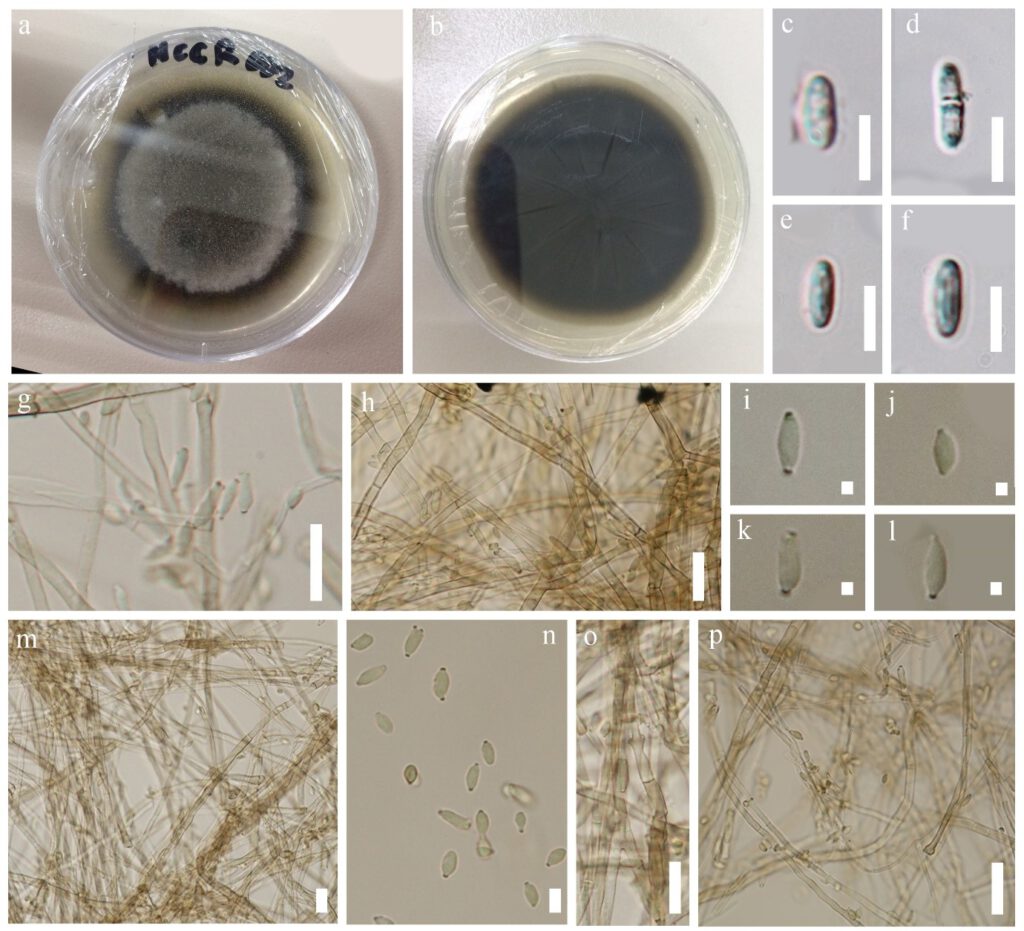Cladosporium colocasiae Sawada, Journal of the Natural History Society Taiwan 25: 125 (1916)
MycoBank number: MB 102626; Index Fungorum number: IF 102626; Facesoffungi number: FoF 10748;
Etymology – Name reflects the host from which the fungus was isolated.
Holotype: Taiwan, on Colocasia esculenta (= C. antiquorum) (Araceae), 2 Jun. 1910, K. Sawada (PPMH). Ex-type culture: CBS 386.64 = ATCC 200944 = MUCL 10084.= Cladosporium colocasiicola Sawada, Special Publ. Coll. Agric. Natl. Taiwan Univ. 8: 195. 1959, nom. inval.
Saprobic on dead leaves of Dracaena sp. Sexual morph: Undetermined. Asexual morph: In vitro: Mycelium immersed and superficial; hyphae loosely branched, septate, not constricted at septa, subhyaline to pale olivaceous-brown, smooth to loosely verruculose, unthickened-walled. Conidiophores macronematous, arising laterally or terminally from hyphae, erect, straight to slightly flexuous, filiform to narrowly cylindrical, nodose, with several nodes being quite apart from each other, broad towards the base, branched, hyaline to pale to medium olivaceous-brown, smooth or sometimes appearing to be reticulate, walls thickened. Conidiogenous cells integrated, terminal and intercalary, cylindrical-oblong, nodose with a single node per cell, scars thickened and conspicuous, protuberant. Conidia 5–6 × 2.5–2.6 μm (x̅ = 5.5 × 2.5 μm; n = 30), solitary or in short, unbranched or branched chains, more or less straight, broadly ellipsoid-subcylindrical to cylindrical, unbranched terminal conidia 0–1-septate, dark brown, smooth to loosely verruculose or reticulate, walls unthickened.
Culture characters – Conidia germinated on PDA within 18 hr. Colonies on PDA reaching 50–60 mm diam. after 2 weeks at 18°C, gray to brown, reverse olivaceous-black, velvety, pulvinate to floccose, with a narrow white or grey-olivaceous margin, regular to slightly undulate, aerial mycelium sparse, growth regular, flat to low convex, numerous small but not very conspicuous exudates formed, sporulation profuse.
Material examined –THAILAND, Chiang Rai Province, dead leaves of Dracaena sp. (Asparagaceae), 17 November 2017, Napalai Chaiwan, NCCR2, ex-type living culture MFLUCC 18–0919.
Host – Apium graveolens, Colocasia antiquorum, Colocasia esculenta (Bensch et al. 2010, Sandoval-Denis et al. 2016), Dracaena sp.—(This study).
Distribution – Africa (Ethiopia, Ghana, Guinea, Mauritius, Nigeria), Asia (Brunei, China, India, Indonesia, Japan, Malaysia, Nepal, Pakistan, Sabah, Sarawak, South Korea), Australasia (American Samoa, Australia, Cook Islands, Federated States of Micronesia, Fiji, French Polynesia, Kiribati, Marshall Islands, New Caledonia, New Zealand, Niue, Palau, Papua New Guinea, Solomon Islands, Tahiti, Tonga, Vanuatu, Western Samoa), Europe (Portugal, Azores), North America (USA), West Indies (Barbados), Central & South America (Brazil, Cuba, Dominican Republic, Puerto Rico),
GenBank accession numbers – ITS: OM908927
Notes – Cladosporium colocasiae have been reported on Colocasia esculenta in many countries (Bensch et al. 2012). In the phylogenetic analysis, our isolate formed the same clade with C. colocasiae with high support (83 % MLBS/1.0 BYPP, Fig. ***). Cladosporium colocasiae is characterized by nodulose conidiophores (Schubert 2005b, Schubert et al. 2007b). Olivaceous-brown dichotomously branched conidiophores 5(–7)-septate with 5 conidia in the chain, verruculose, pale brown, non-septate conidia and cylindrical, 0–1-septate ramoconidia. The type material of Cla. colocasiicola was reported from Colocasia esculenta in culture and published a first detailed description of its features in vitro. With these significant and with phylogenetic support we introduce our isolate as a new host record of Dracaena sp. and a new geological record of C. colocasiae from Thailand.

Figure ***– Cladosporium colocasiae (ex-type living culture MFLUCC 18–0919). a–b Appearance of culture on PDA. c–f, i–l, n Conidia g Conidiogenous cell h, m, o–p Conidiophore Scale bars: i, j, k, l, p =20 μm. c, d, g, h, m, n, o = 500 μm.
